In today’s energy-conscious world, understanding the electricity consumption of household appliances is crucial for managing utility costs and minimizing environmental impact.
Among these appliances, the deep freezer plays a vital role in preserving and storing frozen food items.
However, many individuals may wonder about the energy requirements of a deep freezer and how it contributes to their overall electricity usage.
In this article, we will delve into the question, “How many watts does a deep freezer use?” by exploring the factors that influence its wattage, providing wattage ranges for different deep freezer sizes, and offering valuable insights on optimizing energy efficiency to make informed decisions about this essential appliance.
What Is A Deep Freezer?
A deep freezer, also known as a chest freezer, is a specialized appliance designed to preserve and store food at sub-zero temperatures for extended periods [1].

Design and Features
Deep freezers have a distinct design, typically shaped like a large rectangular box with a hinged lid on top. The lid opens upward, allowing easy access to the contents inside. They come in various sizes, ranging from compact models suitable for small apartments to large commercial units used in restaurants and food storage facilities.
The main feature that sets a deep freezer apart from a regular freezer is its ability to maintain extremely low temperatures. While standard refrigerators maintain temperatures around 0°F (-18°C), a deep freezer can go much lower, typically ranging from -10°F to -40°F (-23°C to -40°C) [2]. This deep freezing capability ensures that food remains frozen solid, preventing the formation of ice crystals and freezer burn that can degrade food quality over time.
Advantages of Using a Deep Freezer
- Extended Storage Life: The lower temperatures in a deep freezer significantly extend the shelf life of frozen food. Meats, vegetables, fruits, and prepared meals can be safely stored for several months without compromising taste or nutritional value;
- Bulk Storage: Deep freezers provide ample space for storing large quantities of food, making them ideal for bulk purchases, seasonal harvesting, or meal prepping. This feature is particularly useful for families, hunters, or those who want to take advantage of sales and discounts;
- Energy Efficiency: Deep freezers are generally more energy-efficient than regular freezers. Once the desired temperature is reached, the insulated design helps maintain the cold without consuming excessive power;
- Emergency Preparedness: Deep freezers can be a valuable asset during emergencies or natural disasters. They allow you to store essential food supplies for an extended period, ensuring you have access to sustenance when needed;
- Food Preservation: Freezing food preserves its nutrients, flavors, and textures better than other preservation methods. This makes deep freezers an excellent choice for storing perishable items for long durations;
Considerations and Maintenance
When purchasing a deep freezer, it’s essential to consider factors such as size, energy efficiency, and available features. Additionally, placing the freezer in a cool, well-ventilated area and ensuring proper organization of stored items can optimize its performance and prolong the lifespan of the appliance.
Regular maintenance, including defrosting when necessary, cleaning the interior, and checking the seals around the lid, will help keep the deep freezer running efficiently.
Factors Impacting A Deep Freezer Wattage
The wattage of a deep freezer is influenced by several factors, each of which plays a role in determining the energy consumption and efficiency of the appliance. Understanding these factors can help consumers make informed decisions when choosing a deep freezer.
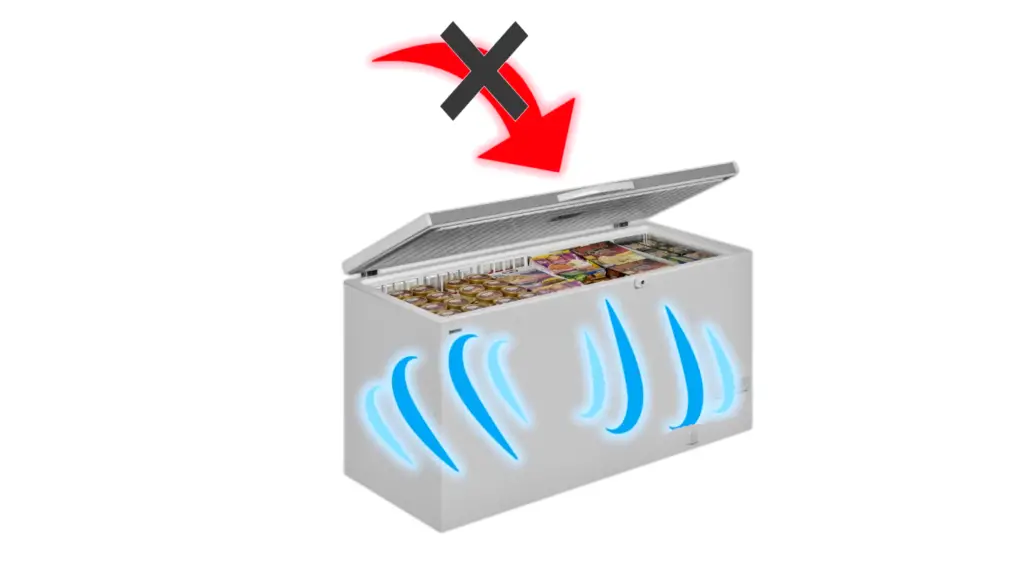
Here are some key factors impacting the wattage of a deep freezer:
- Size and Capacity: The physical size and internal capacity of the deep freezer directly affect its wattage. Larger freezers typically have more powerful compressors to maintain the lower temperatures evenly throughout the storage space, resulting in higher wattage consumption. Conversely, smaller deep freezers with lower capacities may require less power to operate;
- Insulation and Design: The quality and thickness of the insulation used in the deep freezer can impact its energy efficiency. Well-insulated freezers can retain the cold temperature more effectively, reducing the need for the compressor to run frequently. Look for deep freezers with high-quality insulation and energy-efficient designs;
- Temperature Range: The desired temperature range set by the user also affects the freezer’s wattage consumption. Deeper and more extreme freezing temperatures require the compressor to work harder and consume more power. For instance, ultra-low temperature freezers used in scientific or medical applications will have higher wattage ratings compared to standard deep freezers used for household food storage;
- Climate and Ambient Temperature: The external environment in which the deep freezer is placed can impact its wattage. If the freezer is located in a hot and humid climate, the compressor may need to work harder to maintain the internal temperature, resulting in increased wattage usage;
- Frequency of Door Opening: Each time the deep freezer’s door is opened, warm air enters the freezer, and the compressor needs to compensate by running more frequently to bring the temperature back down. Frequent door openings can lead to higher wattage consumption over time;
- Frost Buildup: Frost accumulation on the freezer’s evaporator coils can reduce its efficiency, causing the compressor to work harder and consume more power. Regular defrosting or choosing a frost-free deep freezer can help mitigate this issue;
- Energy Efficiency Rating: When purchasing a deep freezer, look for models with high energy efficiency ratings. Appliances with higher ratings consume less power to achieve the same cooling effect, resulting in lower overall wattage usage and reduced energy bills;
- Age and Condition: Older deep freezers may not be as energy-efficient as newer models due to advancements in technology and design. Additionally, worn-out components, such as faulty gaskets or worn seals, can lead to energy wastage and increased wattage consumption [3];
Deep/Chest Freezer Wattage By Freezer Size:
1) Compact/Small Deep Freezers
Compact or small deep freezers are ideal for individuals or small families with limited storage space. These freezers typically have a capacity ranging from 3 to 9 cubic feet. Due to their smaller size, they are generally more energy-efficient compared to their larger counterparts. The wattage of compact deep freezers typically falls within the range of 80 to 150 watts.
A compact deep freezer with a capacity of around 3 to 5 cubic feet will usually require about 80 to 120 watts to operate efficiently. These models are perfect for storing a limited amount of frozen food items, such as pre-prepared meals, frozen fruits, or a few cuts of meat.

For slightly larger compact deep freezers with a capacity of 7 to 9 cubic feet, the wattage requirement tends to be around 120 to 150 watts. These freezers provide a bit more storage space while still maintaining a reasonable level of energy efficiency [4].
Due to their smaller size and lower wattage requirements, compact deep freezers are an excellent option for those looking to save on energy costs while enjoying the convenience of additional freezer space.
2) Medium Deep Freezers
Medium-sized deep freezers strike a balance between storage capacity and energy efficiency, making them a popular choice for medium-sized families or individuals who require more freezer space. These freezers typically have a capacity ranging from 10 to 18 cubic feet, providing ample room for a variety of frozen food items. The wattage for medium-deep freezers generally falls within the range of 150 to 250 watts.
For medium-deep freezers with a capacity of around 10 to 14 cubic feet, the wattage requirement is typically in the range of 150 to 200 watts. These freezers can comfortably store a moderate amount of frozen vegetables, meats, and frozen treats without consuming excessive energy [5].
For larger medium-sized deep freezers with a capacity of 15 to 18 cubic feet, the wattage requirement tends to be around 200 to 250 watts. These models offer even more storage space for bulk shopping or storing frozen goods for an extended period.
3) Large Deep Freezers
Large deep freezers are designed for those with substantial freezing needs, such as large families, restaurants, or commercial food storage. These freezers typically have a capacity of 20 cubic feet or more. While they offer generous storage space, they do require higher wattage to maintain the lower temperatures efficiently. The wattage for large deep freezers generally falls within the range of 250 to 500 watts.
For deep freezers with a capacity of around 20 to 24 cubic feet, the wattage requirement is typically in the range of 250 to 350 watts. These freezers can accommodate a significant amount of frozen food items, making them suitable for larger households or businesses with moderate freezing needs.
For extra-large deep freezers with a capacity of 25 cubic feet or more, the wattage requirement tends to be around 350 to 500 watts. These freezers are best suited for commercial use or situations where an extensive amount of frozen storage is necessary [6].
Large deep freezers are undeniably powerful in terms of storage capacity, but consumers should be aware of their higher wattage requirements. Proper consideration should be given to the energy costs associated with these models.
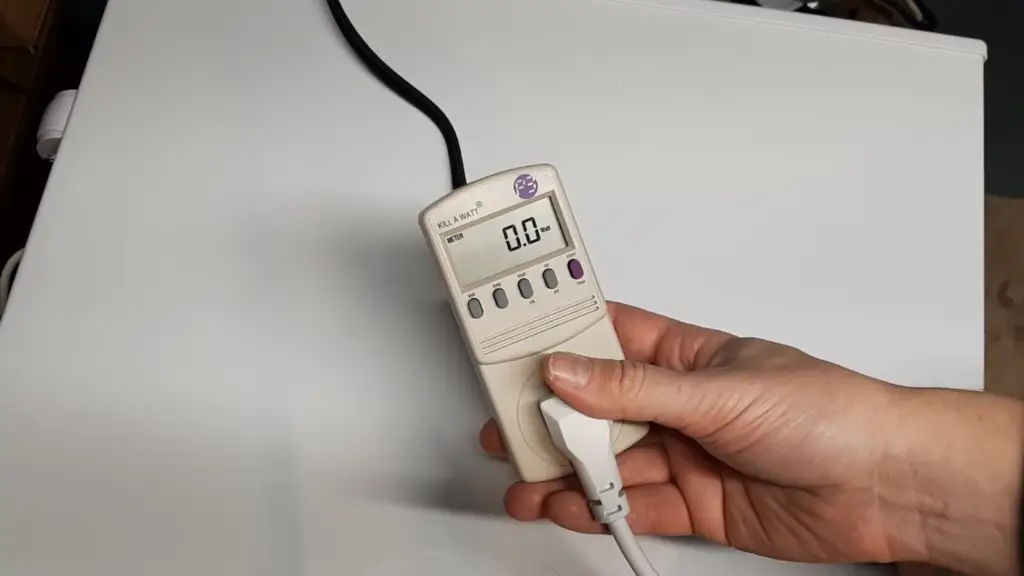
Energy Efficiency Considerations
Regardless of the deep freezer size you choose, it’s essential to consider the energy efficiency rating of the appliance. Energy-efficient models may have slightly higher upfront costs, but they can lead to significant savings on your electricity bills over time. Look for freezers with the ENERGY STAR label, as they meet strict energy efficiency guidelines set by the Environmental Protection Agency (EPA) [7].
Additionally, taking simple steps to maintain your deep freezer, such as keeping the coils clean, ensuring proper door seals, and avoiding frequent door openings, can help optimize its energy efficiency and reduce wattage consumption.
How Many Watts Does A Deep Freezer Use?
The wattage of a deep freezer can vary depending on its size, design, and energy efficiency. As mentioned earlier in the article, different freezer sizes come with varying wattage requirements.
Here is a general overview of the wattage range for different types of deep freezers:
- Compact/Small Deep Freezers: Compact or small deep freezers, with a capacity ranging from 3 to 9 cubic feet, typically use around 80 to 150 watts. Smaller models with a capacity of 3 to 5 cubic feet may require around 80 to 120 watts, while slightly larger compact freezers with a capacity of 7 to 9 cubic feet may use around 120 to 150 watts;
- Medium Deep Freezers: Medium-sized deep freezers, with a capacity ranging from 10 to 18 cubic feet, generally use around 150 to 250 watts. For models with a capacity of 10 to 14 cubic feet, the wattage requirement is usually in the range of 150 to 200 watts. Larger medium-sized freezers with a capacity of 15 to 18 cubic feet may use around 200 to 250 watts;
- Large Deep Freezers: Large deep freezers, designed for substantial freezing needs, typically have a capacity of 20 cubic feet or more. The wattage for large deep freezers generally falls within the range of 250 to 500 watts. For freezers with a capacity of 20 to 24 cubic feet, the wattage requirement is typically in the range of 250 to 350 watts. Extra-large deep freezers with a capacity of 25 cubic feet or more may use around 350 to 500 watts [8];
It’s important to note that these wattage ranges are approximate and can vary depending on the specific model and manufacturer. Additionally, advancements in technology and energy efficiency may lead to newer models using less wattage while still providing sufficient freezing capacity.
To find the exact wattage of a particular deep freezer, you can refer to the manufacturer’s specifications and label at the appliance. The wattage information is usually provided on the product tag or in the user manual.
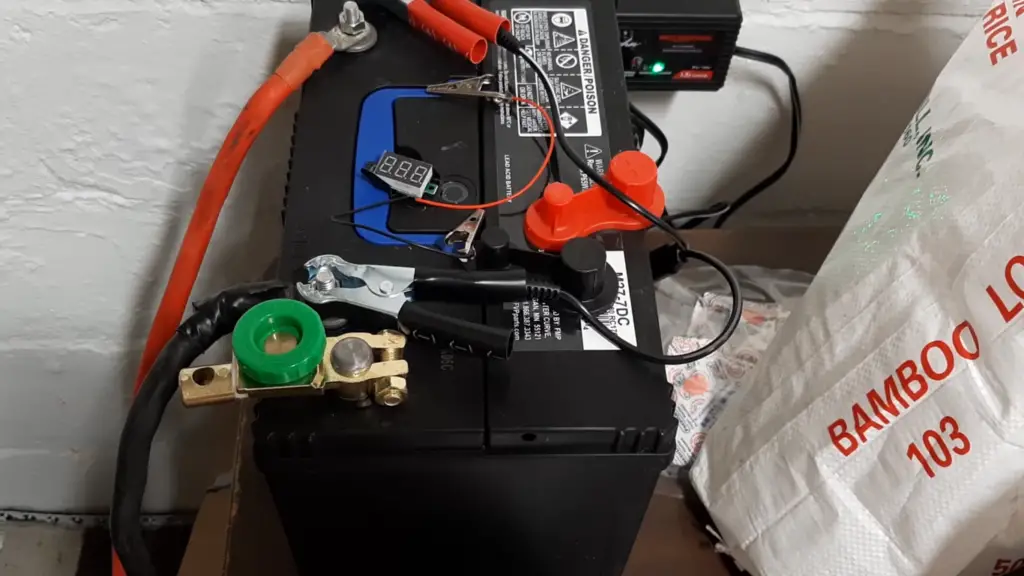
Considering the wattage of a deep freezer is essential when making a purchase decision, as it directly affects energy consumption and, consequently, your electricity bills. Opting for an energy-efficient model with a good ENERGY STAR rating can help you save on energy costs in the long run. Proper maintenance and care of the deep freezer can also optimize its energy efficiency and reduce wattage consumption.
How Much Electricity Does A Deep Freezer Use:
- Compact/Small Deep Freezers: Compact or small deep freezers with a capacity of around 3 to 9 cubic feet typically consume between 100 to 400 kWh (kilowatt-hours) of electricity per year. Smaller models may be on the lower end of the range, while slightly larger compact freezers may use closer to 400 kWh per year;
- Medium Deep Freezers: Medium-sized deep freezers, with a capacity of around 10 to 18 cubic feet, generally consume between 300 to 600 kWh per year. The specific energy consumption will depend on the size, energy efficiency, and usage habits;
- Large Deep Freezers: Large deep freezers, designed for significant freezing needs, have capacities of 20 cubic feet or more. These freezers can consume between 500 to 1000 kWh per year or more, depending on their size and energy efficiency [9];
How Much Does It Cost To Run A Deep Freezer?
The cost to run a deep freezer depends on several factors, including the size of the freezer, its energy efficiency, the local electricity rate, and how you use and maintain the appliance.
Let’s break down the cost to run a deep freezer based on different factors:
- Freezer Size: As discussed earlier, the size of the deep freezer influences its energy consumption. Smaller compact freezers generally cost less to run than larger, more massive models. The larger the freezer, the more electricity it may require to maintain the lower temperatures;
- Energy Efficiency: Energy-efficient deep freezers consume less electricity compared to less efficient models. Choosing a freezer with an ENERGY STAR rating or higher energy efficiency can lead to cost savings over time, even if the upfront cost might be slightly higher;
- Local Electricity Rate: The cost of electricity varies from one location to another. The electricity rate is usually measured in cents per kilowatt-hour (kWh). You can find this information on your electricity bill or by contacting your utility provider;
- Usage Patterns: How often you open the freezer door and how long you keep it open can impact electricity consumption. Frequent door openings and extended open times result in the freezer working harder to maintain the desired temperature, leading to higher energy usage;
- Temperature Settings: Extremely low-temperature settings consume more electricity. Setting the freezer temperature to an appropriate level, usually around 0°F (-18°C), can help optimize energy consumption;
- Maintenance: Proper maintenance, such as keeping the freezer clean, defrosting when necessary, and checking door seals, can help the appliance run more efficiently and reduce energy waste [10];
To estimate the cost to run a deep freezer, you can follow these steps:
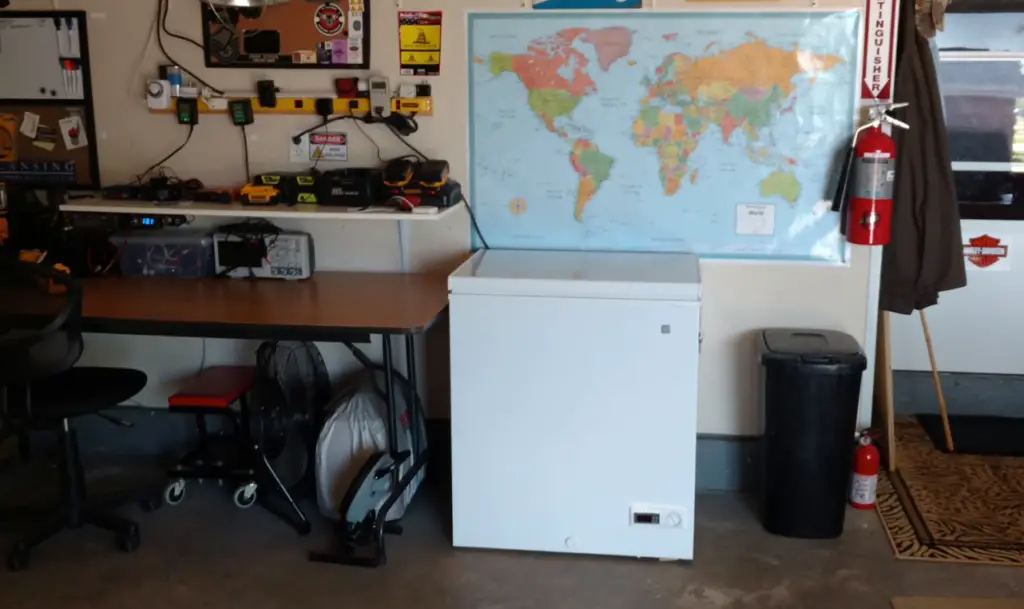
Calculate the daily energy consumption by multiplying the wattage by the number of hours the freezer runs in a day. For example, if your 150-watt freezer runs for 10 hours per day, the daily consumption would be 150 watts * 10 hours = 1500 watt-hours or 1.5 kilowatt-hours (kWh).
Determine the monthly energy consumption by multiplying the daily consumption by the number of days in a month. For example, if the daily consumption is 1.5 kWh and the month has 30 days, the monthly consumption would be 1.5 kWh * 30 days = 45 kWh.
Calculate the monthly cost by multiplying the monthly consumption by your local electricity rate (in cents per kWh). For instance, if your electricity rate is 12 cents/kWh, the monthly cost would be 45 kWh * $0.12/kWh = $5.40 [11].
Keep in mind that these calculations are for illustrative purposes only, and actual costs may vary. It’s essential to consider the specific factors mentioned earlier and adapt the calculations accordingly for your unique situation.
How To Reduce The Electricity Consumption Of Your Deep Freezer:
Keep It Well Stocked
One simple yet effective way to reduce the electricity consumption of your deep freezer is to keep it well stocked. A full freezer is more energy-efficient than an empty one because the frozen items act as thermal mass, helping to maintain the cold temperature when the door is opened. The freezer doesn’t have to work as hard to cool the empty space, reducing energy waste.
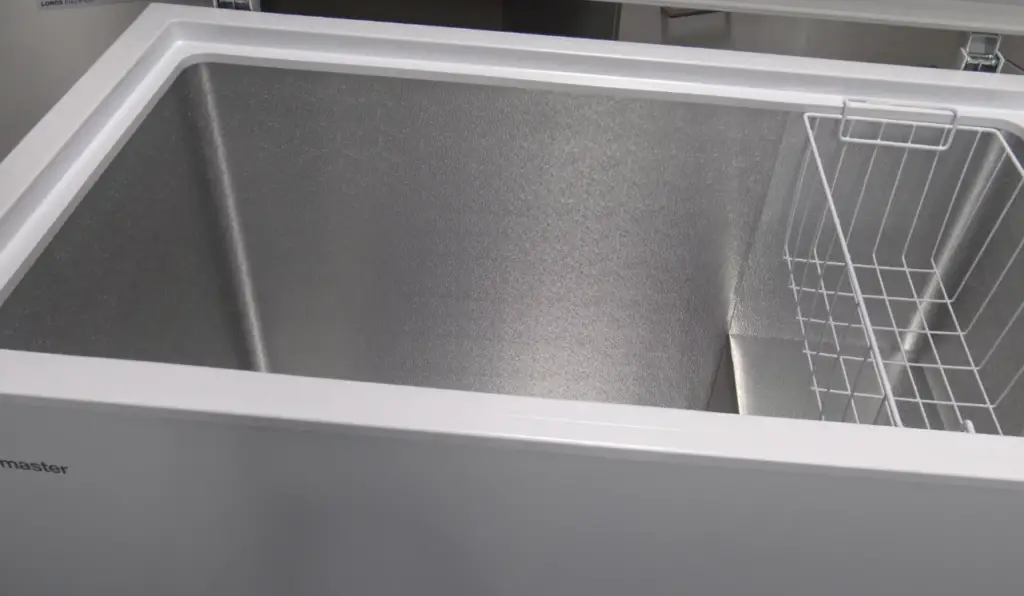
If you don’t have enough frozen food to fill the entire freezer, consider using containers filled with water to take up space. Be sure to leave enough room for proper air circulation around the items to ensure even cooling. A well-stocked freezer not only saves energy but also allows you to take advantage of bulk purchases and store food for extended periods.
In And Out Job
Frequent door openings can significantly impact the electricity consumption of your deep freezer. Each time you open the freezer door, warm air from the surrounding environment enters, and the freezer’s compressor has to work harder to bring the temperature back down. To reduce energy waste, make it an “in and out job” – be decisive when accessing items from the freezer, and avoid leaving the door open for extended periods.
To make this easier, consider organizing the freezer’s contents in a way that allows you to quickly locate and retrieve what you need. You can use labeled bins or baskets to keep similar items together and arrange them in a logical order for easy access. By minimizing door openings and being efficient when retrieving items, you can save on electricity and extend the life of your deep freezer.
Give It Space
Proper ventilation is essential for your deep freezer’s energy efficiency. When placing the freezer, make sure it has adequate space around it for air circulation. Avoid positioning the freezer close to walls or other appliances that might block the airflow. Proper ventilation prevents the compressor from working overtime to dissipate heat, leading to reduced energy consumption.
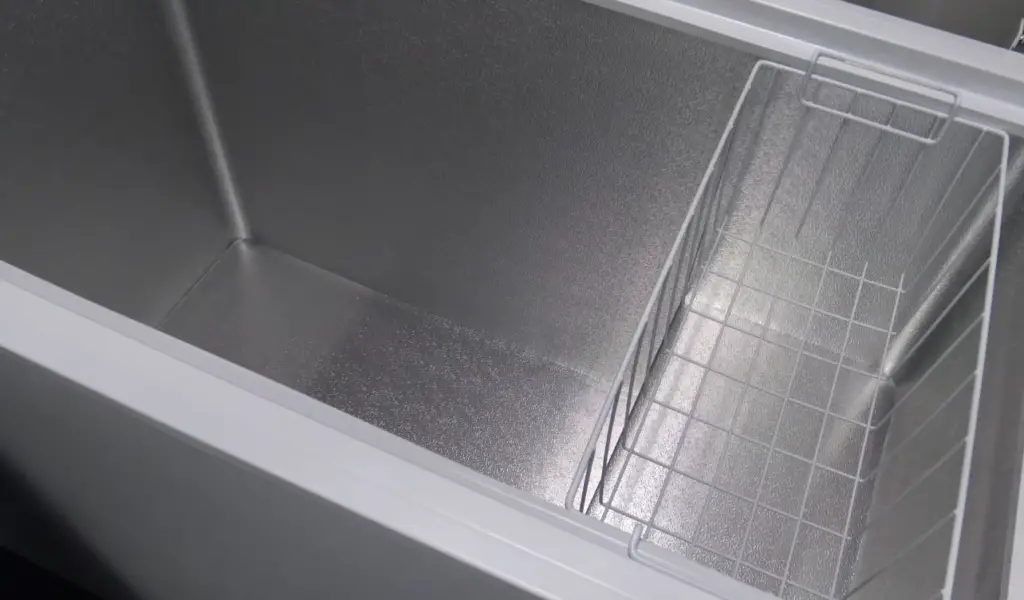
Moreover, placing the freezer in a cool, well-ventilated area can help it maintain the desired temperature more efficiently, especially in hot climates. Avoid locations exposed to direct sunlight or areas with high ambient temperatures, as this can cause the freezer to work harder to keep things frozen.
Keep It Clean
Regular maintenance and cleanliness play a crucial role in reducing the electricity consumption of your deep freezer. Over time, dust and debris can accumulate on the condenser coils and other components, hindering the freezer’s performance and causing it to use more energy. To prevent this, make it a habit to clean the coils and other accessible parts at least once a year.
Additionally, regularly defrosting your freezer is essential for its optimal operation. Ice buildup can act as insulation, making the freezer work harder to maintain low temperatures. Check the manufacturer’s recommendations for defrosting intervals, and be sure to follow them to keep your deep freezer running efficiently.
Swap Old For New
If you have an older deep freezer, it might be worthwhile to consider upgrading to a newer, more energy-efficient model. Advancements in technology and design have led to the development of deep freezers with better insulation and energy-saving features. Look for models with an ENERGY STAR rating, as they meet strict energy efficiency guidelines set by the Environmental Protection Agency (EPA).
While the upfront cost of a new deep freezer may be higher, long-term energy savings can offset the investment. Plus, you’ll benefit from improved performance, reduced electricity consumption, and a more environmentally-friendly appliance [12].
How Can You Make Your Chest Freezer More Energy Efficient:
1. Freezer Locks
Adding a lock to your chest freezer can help improve its energy efficiency by minimizing unintentional door openings. Every time you open the freezer door, warm air from the surrounding environment enters, and the appliance’s compressor has to work harder to cool down the internal temperature. By securing the freezer with a lock, you can prevent unnecessary door openings, especially if you have curious children or if the freezer is in a high-traffic area.
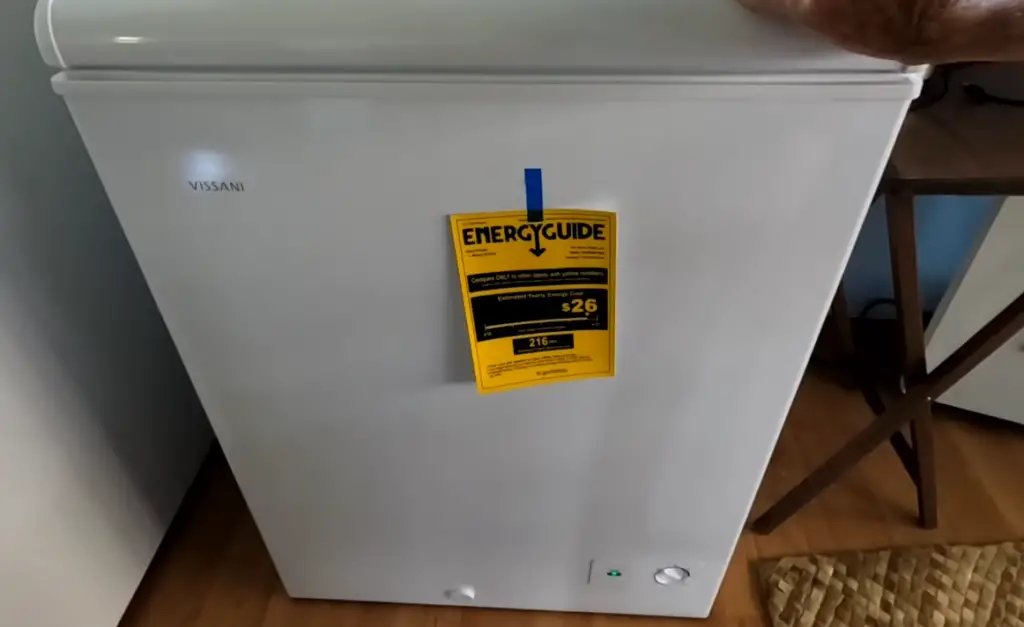
Freezer locks are easy to install and can be found in various styles, including key locks, combination locks, and padlocks. By restricting access and reducing the frequency of door openings, you can keep the freezer’s interior at a stable temperature, resulting in lower energy consumption.
2. Self-Defrosting
Opting for a self-defrosting chest freezer can significantly enhance its energy efficiency. Traditional manual-defrost freezers require periodic defrosting to remove accumulated ice, which can act as insulation and reduce the freezer’s cooling efficiency. During the defrosting process, you typically have to turn off the freezer and let the ice melt, leading to temporary temperature fluctuations and increased energy usage.
Self-defrosting freezers, on the other hand, have a built-in mechanism that automatically defrosts the appliance at regular intervals. This feature prevents ice buildup, ensuring optimal cooling performance and reducing the need for manual defrosting. As a result, self-defrosting chest freezers are generally more energy-efficient and convenient to use.
3. Energy Star Certification
When shopping for a new chest freezer or considering an upgrade, look for models with an ENERGY STAR certification. The ENERGY STAR label indicates that the appliance meets or exceeds strict energy efficiency guidelines set by the Environmental Protection Agency (EPA). Choosing an ENERGY STAR-certified chest freezer ensures that you are getting an energy-efficient appliance that can help you save on electricity costs [13].
ENERGY STAR-certified chest freezers often come equipped with features such as improved insulation, high-efficiency compressors, and better temperature controls, all of which contribute to reduced energy consumption. While the initial cost of an energy-efficient freezer might be slightly higher, the long-term savings in energy bills can make it a worthwhile investment.

Is Having A Deep Freezer Worth It:
- Storage Capacity: One of the main advantages of a deep freezer is the additional storage space it provides. If you regularly purchase food in bulk, harvest fresh produce from your garden, or take advantage of sales and discounts, a deep freezer can help you store these items for extended periods. This can lead to cost savings by buying in bulk and reducing food waste;
- Convenience: A deep freezer offers the convenience of having a wide variety of frozen food items readily available at any time. You can stock up on pre-prepared meals, frozen fruits and vegetables, meats, and other perishable items, making meal planning and preparation more convenient and efficient;
- Long-Term Food Preservation: Freezing is one of the most effective methods of food preservation. With a deep freezer, you can freeze food items at ultra-low temperatures, preserving their nutrients, flavors, and textures for an extended period. This is particularly useful for storing seasonal produce or prepared meals that can be enjoyed throughout the year;
- Emergency Preparedness: In times of emergencies or natural disasters, a deep freezer can be a valuable asset. It allows you to store essential food supplies, providing a steady source of sustenance when access to fresh food is limited;
- Cost Savings: While a deep freezer has an initial cost, it can lead to long-term cost savings by enabling you to take advantage of sales and discounts, reducing food waste, and avoiding last-minute grocery trips;
- Energy Consumption: It’s essential to consider the energy consumption of a deep freezer. While they are generally more energy-efficient than older models, they still contribute to electricity consumption. However, this cost can often be offset by the savings achieved through buying in bulk and preserving food for longer;
- Available Space: Consider the available space in your home or apartment. Deep freezers come in various sizes, so make sure you have adequate space to accommodate the freezer without it becoming a hindrance;
- Frequency of Use: Assess how frequently you would use the deep freezer. If you rarely use frozen food or prefer fresh produce, a deep freezer might not be as beneficial for you;
- Upfront Investment: The cost of purchasing a deep freezer is a significant consideration. If your budget allows for the investment, and you can see the potential benefits based on your lifestyle and needs, it may be worth it;
- Future Lifestyle Changes: Consider any potential lifestyle changes in the near future. If you anticipate a change in household size or needs, factor that into your decision;
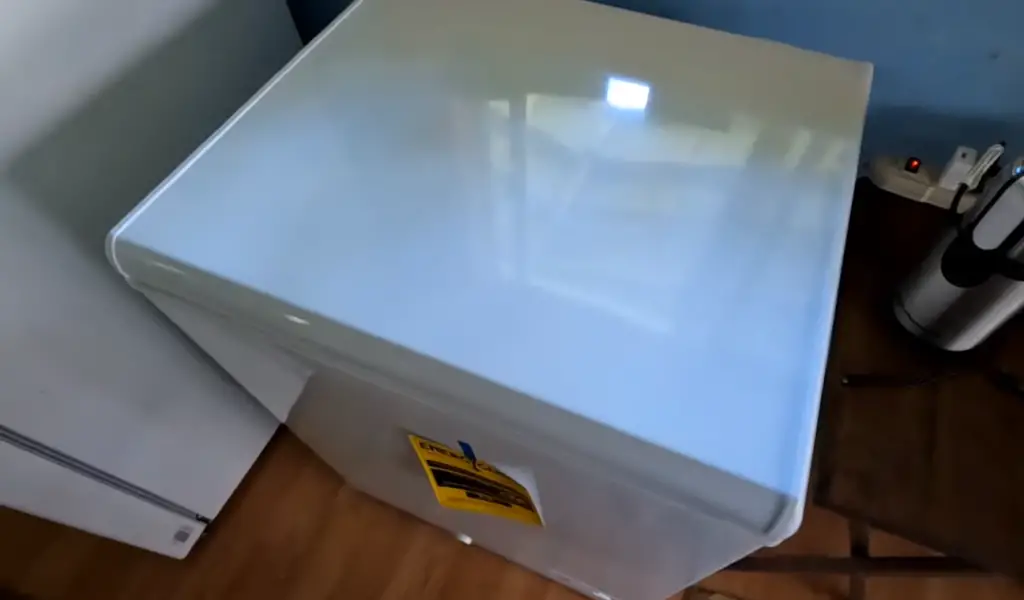
FAQ:
1. How much electricity do freezers use by brand?
The electricity consumption of freezers can vary by brand and model. Each manufacturer may design their freezers with different energy efficiency levels. To determine the electricity usage of a specific freezer model by brand, you can refer to the manufacturer’s specifications, user manual, or the ENERGY STAR label (if applicable). The ENERGY STAR label provides information about the appliance’s energy efficiency, allowing you to compare different brands and choose a more energy-efficient option.
2. How many watts does an upright freezer use?
The wattage of an upright freezer can vary depending on its size, energy efficiency, and other features. Generally, an upright freezer with a capacity of around 15 to 20 cubic feet may use approximately 150 to 300 watts. However, these are just rough estimates, and actual wattage can vary by model. To find the exact wattage for a specific upright freezer, you can check the manufacturer’s specifications or label on the appliance.
3. How many watts does a chest freezer use?
The wattage of a chest freezer can vary based on its size, energy efficiency, and other factors. For a standard chest freezer with a capacity of around 15 to 20 cubic feet, the wattage typically falls within the range of 100 to 300 watts. For more precise information, refer to the manufacturer’s specifications or the label on the chest freezer.
4. How many watts does a deep freezer use?
A deep freezer, also known as a chest freezer, generally has wattage requirements similar to those of a chest freezer. The wattage can range from around 100 to 300 watts, depending on the size and energy efficiency of the appliance.
5. How many watts does a compact freezer use?
A compact freezer, which is smaller in size and typically has a capacity of 3 to 5 cubic feet, may use approximately 80 to 120 watts. Compact freezers are designed to be more energy-efficient due to their smaller size.
6. Can I plug a chest freezer into a surge protector?
Yes, you can plug a chest freezer into a surge protector. It is generally safe to use a surge protector to protect the freezer from power surges and voltage spikes. However, ensure that the surge protector is appropriately rated for the freezer’s power consumption and that it is of good quality to provide reliable protection.
7. Can you plug a deep freezer into a power strip?
Yes, you can plug a deep freezer into a power strip, but it’s essential to use a power strip that can handle the freezer’s wattage and electrical requirements. Look for a power strip with a high enough wattage rating and ensure it has surge protection features to safeguard the freezer from power fluctuations.
8. Does a freezer in the garage use more electricity than in a house?
In certain situations, a freezer in the garage may use slightly more electricity than one inside the house. Garages are typically not insulated or temperature-controlled like the interior of a house. If the garage experiences extreme temperature fluctuations, the freezer may need to work harder to maintain its internal temperature, leading to slightly higher energy consumption.
However, the difference in energy usage is generally minimal for well-insulated and energy-efficient freezers.
9. Can solar power a deep freezer?
Yes, solar power can be used to run a deep freezer. Solar panels generate electricity from sunlight, and this energy can be used to power the freezer directly or stored in batteries for use during cloudy periods or at night. For solar powering a deep freezer, you’ll need an appropriately sized solar panel system and a battery storage solution to ensure a consistent power supply.
10. What is the smallest size deep freezer?
The smallest size for a deep freezer is typically around 3 to 5 cubic feet, sometimes referred to as a compact deep freezer. These smaller models are suitable for individuals or small families with limited freezer storage needs.
11. What uses more electricity – the fridge or the freezer?
In general, a fridge uses more electricity than a freezer. Refrigerators are constantly running to maintain a cool temperature, while freezers, especially well-insulated ones, can retain their cold temperatures for longer periods, leading to shorter and less frequent compressor cycles.
12. How many watts does a small freezer use?
A small freezer, such as a compact or mini freezer with a capacity of around 3 to 5 cubic feet, may use approximately 80 to 150 watts, depending on the model and energy efficiency.
13. How much power does a 7 cubic foot freezer use?
A 7 cubic foot freezer may use around 100 to 200 watts, depending on the model and energy efficiency.
14. How many watts does it take to run a deep freezer and refrigerator?
The total wattage to run a deep freezer and a refrigerator will depend on the specific models and their sizes. Generally, a deep freezer and refrigerator together may consume around 300 to 800 watts. However, this is an estimate, and the actual wattage will vary based on individual models and usage patterns.
15. What is the difference between a freezer and a deep freezer?
The terms “freezer” and “deep freezer” are often used interchangeably, but they can refer to different types of appliances. A freezer can refer to any appliance that is designed to freeze and store food at sub-zero temperatures. This includes both chest freezers and upright freezers.
On the other hand, a “deep freezer” usually specifically refers to a chest freezer. Chest freezers have a distinct design, with a top-opening lid and a larger storage capacity compared to upright freezers.
16. Are deep freezers worth it?
Whether a deep freezer is worth it depends on individual needs and circumstances. For those who benefit from extra freezer storage for bulk purchases, food preservation, or emergency preparedness, a deep freezer can be a valuable and cost-effective investment. It allows you to save on grocery costs, reduce food waste, and conveniently store a variety of frozen food items.
17. Can a 2000-watt inverter run a deep freezer?
Yes, a 2000-watt inverter should be sufficient to run a deep freezer. Deep freezers typically have wattage requirements ranging from 100 to 300 watts, and a 2000-watt inverter can handle this power demand comfortably.
18. Does a deep freezer work better full or empty?
A deep freezer works more efficiently when it is full. When the freezer is full, the frozen items help retain the cold temperature, reducing temperature fluctuations when the door is opened. This means the compressor has to run less frequently, leading to energy savings.
19. How much electricity does a deep freezer use per day?
The electricity consumption of a deep freezer per day can vary depending on factors like the freezer’s size, energy efficiency, usage patterns, and environmental conditions. As a rough estimate, a deep freezer with a capacity of around 15 to 20 cubic feet may use approximately 0.5 to 1.5 kWh (kilowatt-hours) per day.
20. Do deep freezers get colder than freezers?
Deep freezers and regular freezers can both reach extremely low temperatures well below freezing. The cooling ability depends on the design and compressor of the freezer rather than its name. Both types can achieve similar low temperatures for food preservation.
21. What is the most energy-efficient freezer?
The most energy-efficient freezers are those that have earned the ENERGY STAR certification. ENERGY STAR-certified freezers meet strict energy efficiency guidelines set by the Environmental Protection Agency (EPA). These freezers are designed to use less electricity while still providing excellent freezing capabilities.
22. Does a chest freezer use more electricity than a fridge?
In general, chest freezers tend to use slightly less electricity than refrigerators. Chest freezers have a more straightforward design and better insulation, which helps them retain their cold temperature efficiently.
On the other hand, refrigerators have more complex systems and frequent door openings, making them use slightly more electricity on average.
23. Do chest freezers use a lot of electricity?
Chest freezers can consume electricity, but their energy usage is generally considered to be reasonable. Newer chest freezer models are designed to be more energy-efficient, and their lower operating costs can offset the initial investment over time. Being mindful of energy-saving practices can further reduce the electricity consumption of a chest freezer.
Useful Video: Deep Freezers use WAY less energy than you think
References
- https://www.ecoenergygeek.com/how-many-watts-deep-freezer-use
- https://ecocostsavings.com/freezer-wattage-energy-efficient/
- https://howdykitchen.com/how-many-watts-does-a-chest-freezer-use/
- https://www.circuitsgallery.com/how-many-watts-does-a-deep-freezer-use/
- https://www.homedetailed.com/how-many-watts-does-a-freezer-use-calculator/
- https://energyusecalculator.com/electricity_freezer.htm
- https://www.hunker.com/13408418/how-many-watts-does-the-average-freezer-require
- https://homedecorbliss.com/how-many-watts-does-a-chest-freezer-use/
- https://homelyville.com/freezer-power-consumption/
- https://savejoules.com/deep-freezers.html
- https://www.launchknowledge.com/how-many-watts-does-a-freezer-use/
- https://www.ukchestfreezers.co.uk/chest-freezer-energy-consumption
- https://www.appliancecity.co.uk/refrigeration/freezers/how-much-energy-does-my-freezer-use/










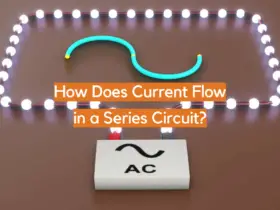

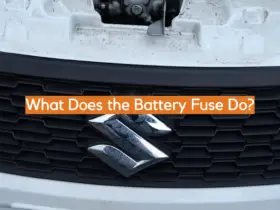

Leave a Reply